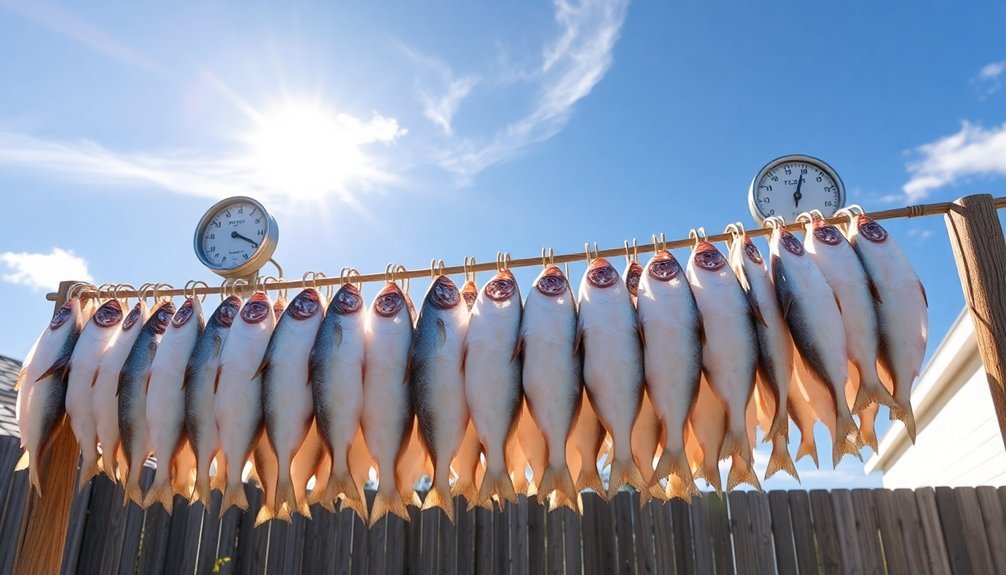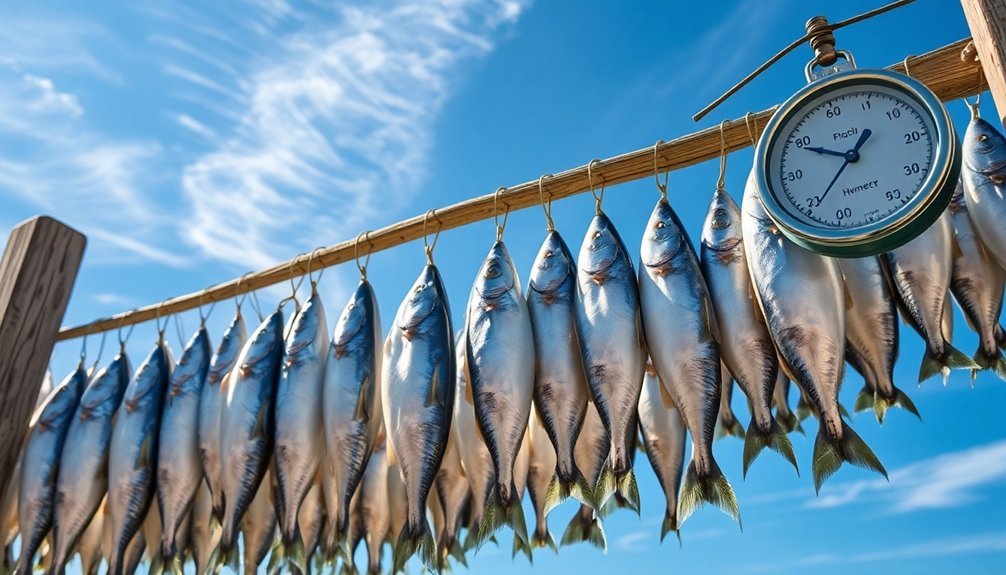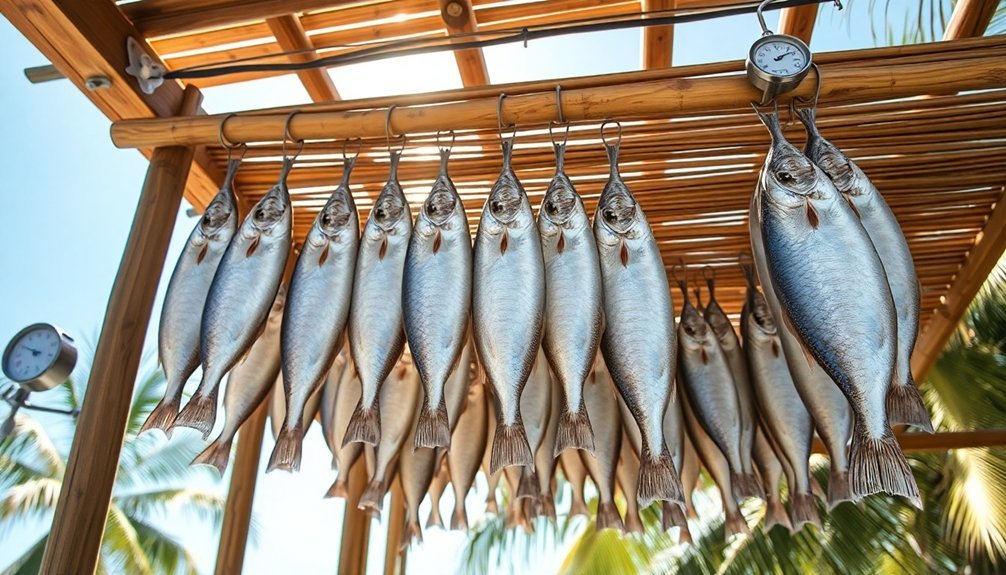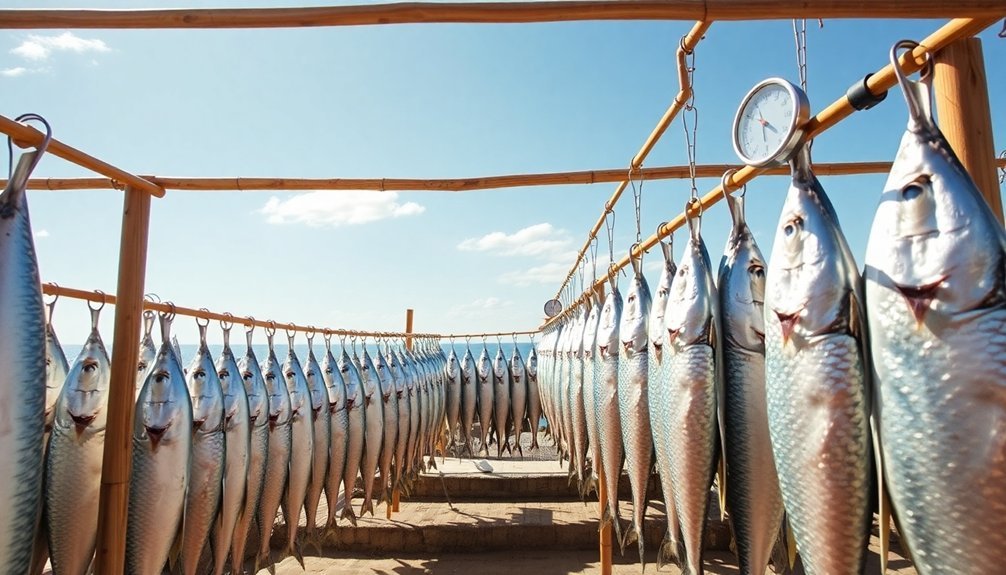You'll get the best results air-drying fish when temperatures stay between 25-30°C, with 27°C being ideal. Keep humidity levels between 35-55% to prevent both slow drying and surface cracking. You need consistent airflow at 2-3 m/s, which you can achieve through proper rack positioning or mechanical ventilation. While natural sunlight helps, it's not essential – what matters most is maintaining stable environmental conditions and protecting your fish from moisture during non-drying periods. Cover your fish at night and during rain to prevent moisture absorption. These key climate factors will determine your success, but there's much more to mastering the perfect dry.
Optimal Air Temperature Range

While air-drying fish requires careful attention to several factors, maintaining the right temperature range is absolutely critical.
You'll want to keep the air temperature between 25°C and 30°C, with 27°C being the sweet spot for ideal results. Never let temperatures exceed 40°C, as this can cause unwanted changes in your fish.
Regular temperature monitoring is essential, as temperature fluctuations can significantly reduce fish quality and storage life. If you're working with tropical fish species, you can push the temperature up to 40°C, but it's still safer to stay within the recommended range. You'll find that lower temperatures help preserve the nutritional value of your fish better, even though they might extend the drying time slightly.
For specific drying methods, you'll encounter different temperature ranges. If you're using sun drying, expect temperatures between 24.5°C and 40°C, depending on weather conditions.
Industrial dryers operate best between 35°C and 40°C, while solar tunnel dryers can reach up to 52.2°C. When using low-temperature dehydration, though temperatures can go up to 80°C, you'll get better nutritional preservation by staying at the lower end of the range.
Remember to maintain consistent temperatures throughout the process to guarantee uniform drying.
Air Movement and Wind Speed
Temperature control works hand in hand with proper air movement to create ideal drying conditions. When you're drying fish, you'll want to guarantee there's sufficient air circulation to prevent case hardening and promote even moisture removal.
Wind patterns can significantly impact drying effectiveness by stirring sediments and creating beneficial air currents.
The process relies on three distinct air layers around your fish: a stationary layer directly on the surface, a slow-moving middle layer, and an outer turbulent layer.
You'll get the best results when you have consistent wind speed or mechanical air movement. Higher air velocity reduces the thickness of the slow-moving layer, which helps moisture escape more quickly from your fish.
If you're using a mechanical dryer, you'll benefit from fan-driven air streams that provide controlled circulation. For sun drying methods, natural wind speeds play a significant role in carrying moisture away from the fish surface.
When stacking fish for drying, maintain a thickness of 10-20cm to allow proper airflow between layers. If you're using a mechanical dryer, make sure it has proper air intake and discharge systems.
The key is to maintain steady air movement that's strong enough to carry away moisture but not so powerful that it damages the fish's surface.
Humidity Level Impact

Relative humidity greatly influences the success of your fish-drying process. You'll need to maintain humidity levels between 35% and 55% for ideal results, as higher levels above 60% will considerably slow down drying, while levels below 35% can cause your fish to dry too quickly and develop surface cracks.
Similar to hygroscopic materials in museum settings, organic fish tissue will absorb and release moisture until it reaches equilibrium with the surrounding air.
To achieve the best results, you should pay attention to these critical humidity factors:
- Keep humidity between 45-55% to prevent surface hardening and guarantee proper moisture diffusion from the fish's interior to its surface.
- Monitor humidity levels closely when temperatures reach 40°C, as high humidity combined with high heat can actually cook the fish instead of drying it.
- Use humidity sensors and regulators if you're working with industrial or solar tunnel dryers to maintain consistent conditions.
When you're drying fish in tropical conditions, you'll want to maintain temperatures around 27°C while keeping humidity between 45-55%. This combination provides the most effective moisture removal rate without compromising quality.
If you notice any case hardening or surface cracking, it's a clear sign that you need to adjust your humidity levels immediately.
Natural Sunlight Exposure
The process typically spans several days, and you'll need to protect your fish from moisture during non-drying periods.
When night falls or rain threatens, remove the fish from the racks and stack them carefully. You can cover them with plastic or use weights to prevent moisture absorption.
Proper Airflow Management

Managing proper airflow requires you to maintain speeds between 2-3 meters per second for ideal drying conditions in your fish preservation setup.
You'll want to position your drying racks to take advantage of natural wind patterns while ensuring consistent air movement through mechanical ventilation when natural circulation isn't sufficient.
Whether you're using natural or mechanical methods, it's critical to keep air moving evenly across all fish pieces to prevent moisture buildup and potential spoilage.
Optimizing Natural Air Circulation
Successful air-drying of fish depends heavily on proper airflow management through natural ventilation.
You'll need to maintain an air velocity between 1 to 2 m/s to guarantee effective moisture removal while preventing skin hardening. Natural air circulation can work efficiently in any climate, but you must provide adequate protection from rain, insects, and dust to preserve product quality.
To optimize natural air circulation in your drying area, follow these key requirements:
- Position your drying racks in well-ventilated spaces where air velocity stays within 1.5 to 2 m/s, as this range works best for most fish species and promotes consistent drying.
- Monitor temperature levels to keep them between 25°C and 30°C, as this guarantees proper moisture removal without risking case hardening that occurs above 40°C.
- Control relative humidity to stay between 45% and 55%, since higher levels above 60% will greatly reduce drying efficiency even with good airflow.
You don't need direct sunlight for effective air-drying, but you must maintain consistent environmental conditions to predict and manage the drying process accurately.
Remember that good air circulation becomes even more critical when relative humidity affects drying at lower air velocities.
Mechanical Ventilation Systems
Modern mechanical ventilation revolutionizes fish air-drying by providing precise control over airflow distribution and temperature management. You'll find that dual plenum systems and strategically placed air ducts guarantee uniform hot air circulation throughout the drying chamber, while circulating fans efficiently direct airflow through heating elements before reaching your product.
To maximize your drying effectiveness, mechanical systems maintain temperatures between 30°C and 60°C, with ideal results typically achieved between 40°C and 60°C. You'll need to monitor these key components:
| Component | Function | Benefits |
|---|---|---|
| Circulation Fans | Distribute heated air | Uniform drying, prevents hot spots |
| Heat Exchangers | Recover waste heat | Enhanced energy efficiency |
| Exhaust Systems | Remove moist air | Prevents humidity buildup |
| Temperature Controls | Maintain consistent heat | Protects product quality |
Your mechanical ventilation system should incorporate energy-efficient direct drive motors and sealed circulation designs to minimize heat loss. The continuous airflow removes moisture effectively while preventing mold growth, and automatic temperature controls guarantee your fish maintains ideal quality throughout the drying process.
Weather Pattern Considerations
You'll need to identify both seasonal and daily weather patterns to optimize your fish drying process, as different regions experience varying periods of ideal drying conditions throughout the year.
Your most successful drying will occur during dry seasons with consistent temperatures between 21-25°C and relative humidity around 30%.
When planning your daily drying schedule, you should monitor weather forecasts to avoid rain periods and take advantage of offshore winds, which typically provide the best drying conditions.
Seasonal Drying Windows
Understanding seasonal weather patterns plays an important role in air-drying fish effectively. You'll find that each season presents unique challenges and opportunities for the drying process.
Spring and fall typically offer ideal conditions with their cooler temperatures and lower humidity levels, making them perfect for achieving properly dried fish.
During summer months, you'll need to adapt your techniques to combat higher humidity and wet weather. Making thinner cuts and ensuring maximum air circulation becomes vital to prevent mold growth.
Winter's cold temperatures can slow the process but offer naturally low humidity levels that work in your favor.
- Use appropriate wood types for different seasons:
- Alder and cottonwood work well in spring
- Birch provides extra heat during damp summer conditions
- Birch continues to be effective in winter for both heat and flavor
To maximize your success, you'll want to focus on periods of stable weather, particularly after cold fronts when air is drier and cooler.
Using wire mesh racks and traditional cutting methods that expose more flesh to air and smoke will help you achieve better results across all seasons.
Remember to adjust your cutting thickness based on seasonal conditions – thinner cuts for wetter seasons and standard cuts for drier periods.
Daily Weather Patterns
Daily weather fluctuations play an essential role in successful fish air-drying. You'll need to monitor both daytime and nighttime conditions to achieve ideal results. During daylight hours, you should aim for temperatures between 25-30°C while maintaining relative humidity between 45-55%. When temperatures rise above 40°C, you'll need to provide shelter from direct sunlight to prevent overheating.
| Time Period | Ideal Conditions | Required Actions |
|---|---|---|
| Morning | Rising temps, low humidity | Position racks for maximum sun/wind exposure |
| Midday | Peak temps, moderate humidity | Monitor for overheating, adjust shelter if needed |
| Evening | Declining temps, rising humidity | Remove fish or cover to prevent moisture absorption |
You'll want to maintain constant air flow between 1-2 m/s throughout the day, increasing to 3 m/s at the top of your drying area to prevent skin from becoming a moisture barrier. During periods of high humidity or rain, you'll need to remove your fish from the racks or cover them properly. Remember that clear skies and dry weather are your best allies for successful air-drying, so plan your daily drying schedule around these ideal conditions.
Frequently Asked Questions
How Does Fish Thickness Affect the Recommended Drying Time and Temperature?
You'll need longer drying times for thicker fish fillets. As thickness increases from 3mm to 7mm, you should extend drying time. For best results, maintain temperatures between 60-70°C for consistent drying.
Can Fish Be Dried Successfully Indoors Using Artificial Climate Control?
Yes, you can successfully dry fish indoors with proper climate control. You'll need to maintain 8-12°C temperatures, keep humidity below 45% RH, and guarantee good air circulation using dehumidifiers and ventilation systems.
What Signs Indicate That Fish Is Becoming Over-Dried During the Process?
You'll notice your fish is over-dried when it's overly brittle, breaks easily when bent, and lacks natural flexibility. Watch for cracked surfaces, unnatural color changes, and an unpleasantly strong odor during drying.
How Do Different Fish Species Respond to Various Drying Conditions?
You'll find that hardy species like carp and catfish tolerate drying better than delicate ones like tuna. They'll dry more evenly at lower temperatures, while all species show less stress in cooler conditions.
Should Drying Conditions Be Adjusted Based on Fish Oil Content?
Yes, you'll need to adjust drying conditions for oily fish. Use lower temperatures (40-50°C), increase air velocity, and consider cutting thinner pieces. High oil content slows drying, so you'll require longer processing times.
In Summary
You'll find the most success in air-drying fish when you consistently maintain temperatures between 70-85°F, guarantee steady airflow, and keep humidity below 60%. Make certain you're providing adequate sun exposure while protecting against sudden weather changes. Remember, it's crucial to adjust your drying setup based on local climate patterns. If you follow these key factors, you'll produce safely dried fish with ideal texture and flavor.





Leave a Reply